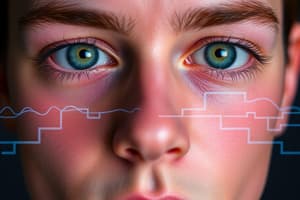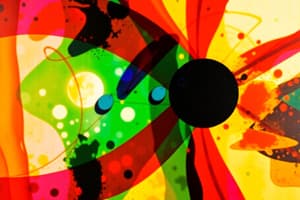Podcast
Questions and Answers
What is the principle behind Signal Detection Theory?
What is the principle behind Signal Detection Theory?
- Detection of stimuli is consistent across all individuals.
- Stimuli are detected based on absolute thresholds.
- Sensation thresholds are fixed and unchanging.
- Detection depends on the difference between stimuli and background noise. (correct)
Which sensory system is primarily responsible for balance and position in space?
Which sensory system is primarily responsible for balance and position in space?
- Vestibular System (correct)
- Olfactory System
- Auditory System
- Kinesthetic Sense
How does the amplitude of sound waves affect our perception?
How does the amplitude of sound waves affect our perception?
- It determines the frequency of the sound.
- It influences the loudness of the sound. (correct)
- It has no effect on perception of sound.
- It affects the quality or timbre of the sound.
What are monocular depth cues primarily used for?
What are monocular depth cues primarily used for?
What does the concept of perceptual set refer to?
What does the concept of perceptual set refer to?
What phenomenon describes the limited capacity of attention as seen in situations like the Cocktail Party Effect?
What phenomenon describes the limited capacity of attention as seen in situations like the Cocktail Party Effect?
Which depth cue relies on the angle at which both eyes converge on an object?
Which depth cue relies on the angle at which both eyes converge on an object?
What aspect of sound is primarily determined by the frequency of sound waves?
What aspect of sound is primarily determined by the frequency of sound waves?
Which theory explains motion sickness as a conflict between sensory inputs from the vestibular system and other senses?
Which theory explains motion sickness as a conflict between sensory inputs from the vestibular system and other senses?
What processing method is characterized by starting at the sensory data level and moving to higher cognitive levels?
What processing method is characterized by starting at the sensory data level and moving to higher cognitive levels?
What does the term 'transduction' refer to in the context of sensation?
What does the term 'transduction' refer to in the context of sensation?
Which type of threshold refers to the minimum difference between two stimuli that a subject can detect?
Which type of threshold refers to the minimum difference between two stimuli that a subject can detect?
What principle does Weber's Law illustrate regarding Just Noticeable Differences (JND)?
What principle does Weber's Law illustrate regarding Just Noticeable Differences (JND)?
Which of the following statements best describes psychophysics?
Which of the following statements best describes psychophysics?
Which of the following sense organs is primarily responsible for detecting pressure?
Which of the following sense organs is primarily responsible for detecting pressure?
What is the correct description of the absolute threshold?
What is the correct description of the absolute threshold?
Which element is considered to be neither the stimulus nor the sensation itself, but instead contributes to perception?
Which element is considered to be neither the stimulus nor the sensation itself, but instead contributes to perception?
In psychophysics, what does the term 'physical stimuli' refer to?
In psychophysics, what does the term 'physical stimuli' refer to?
Which statement is true regarding perceptions?
Which statement is true regarding perceptions?
Which of the following options best lists the sensory modalities involved in sensation?
Which of the following options best lists the sensory modalities involved in sensation?
Flashcards
Sensation
Sensation
The process of detecting, converting, and transmitting raw sensory information from sense receptors to the brain.
Perception
Perception
The experience of our brain assembling and combining sensory input into meaningful patterns.
Psychophysics
Psychophysics
The study of the relationship between physical stimuli and the corresponding sensations they evoke.
Absolute Threshold
Absolute Threshold
Signup and view all the flashcards
Just Noticeable Difference (JND)
Just Noticeable Difference (JND)
Signup and view all the flashcards
Weber's Law
Weber's Law
Signup and view all the flashcards
Transduction
Transduction
Signup and view all the flashcards
Sensory Receptors
Sensory Receptors
Signup and view all the flashcards
Perception
Perception
Signup and view all the flashcards
Perceptions
Perceptions
Signup and view all the flashcards
Difference Threshold
Difference Threshold
Signup and view all the flashcards
Signal Detection Theory
Signal Detection Theory
Signup and view all the flashcards
Kinesthesis
Kinesthesis
Signup and view all the flashcards
Vestibular Sense
Vestibular Sense
Signup and view all the flashcards
Motion Sickness
Motion Sickness
Signup and view all the flashcards
Selective Attention
Selective Attention
Signup and view all the flashcards
Divided Attention
Divided Attention
Signup and view all the flashcards
Cocktail Party Effect
Cocktail Party Effect
Signup and view all the flashcards
Inattentional Blindness
Inattentional Blindness
Signup and view all the flashcards
Perceptual Constancies
Perceptual Constancies
Signup and view all the flashcards
Study Notes
Sensation and Perception
- Knowledge originates from perceptions.
- Sensation involves detecting, converting, and transmitting raw sensory information to the brain from sense receptors.
- Sense organs include eyes, ears, nose, tongue, skin, and internal organs.
- Perception is the brain's assembly and combination of sensory input into meaningful patterns.
- Perceptions are personal interpretations of reality.
Psychophysics
- Studies the relationship between physical stimuli and the sensations they evoke.
- Examples: brightness (light), volume (sound), weight (pressure), sweetness (taste).
- Transduction converts physical energy (light waves, sound waves, pressure) into neural signals.
Sensation Thresholds
- Absolute Threshold: The minimum stimulation needed to detect a stimulus 50% of the time.
- Difference Threshold (JND): The minimum difference between two stimuli that a person can detect 50% of the time.
- Weber's Law: The JND is a constant proportion of the original stimulus intensity, not a constant amount.
Signal Detection Theory
- Predicts how and when we detect a stimulus (signal) amidst background noise.
- No single absolute threshold exists; detection varies among and within individuals.
Somesthetic Senses
- Vestibular Sense: Balance and body position in space (semicircular canals in the ear filled with fluid).
- Kinesthetic Sense: Body position and movement of individual body parts.
- Touch (Somatosensory): Pressure, warmth, cold, and pain.
Vestibular System and Motion Sickness
- Motion sickness arises from conflicting sensory information; vestibular system sensations don't match eye and body sensations.
Audition (Hearing)
-
Transduction of air pressure waves (sound waves) into neural impulses.
-
Sound Waves: Oscillations of pressure that stimulate the hearing organs.
-
Amplitude: Perceived as loudness (height of the waves).
-
Frequency: Perceived as pitch (number of waves in a given time).
-
Sound Localization: Sounds are heard first and loudest by the nearest ear.
Factors Influencing Perception
- Attention (selective vs. divided).
- Organization (figure-ground).
- Expectations (Perceptual Set).
- Motivation.
Perceptual Attention
-
Selective Attention: Focusing on one stimulus.
-
Divided Attention: Splitting focus between tasks.
-
Cocktail Party Effect: Focusing on a conversation amongst other conversations.
-
Inattentional Blindness: Inability to perceive sensory stimuli due to limited attentional capacity.
Perceptual Constancies
- Experience of constant perception despite changing retinal images.
- Examples: Color, size, and shape constancy.
Depth Perception
- Judging distance and seeing in three dimensions.
- Monocular Depth Cues: Clues based on cues from one eye.
- Examples: Linear perspective, relative size, relative height, interposition, texture gradient, light and shadow, accommodation.
- Binocular Depth Cues: Clues based on differing views from two eyes.
- Examples: Convergence, retinal disparity.
Perceptual Expectations (Perceptual Set)
- Predisposition to perceive things a certain way based on past experiences, thoughts, and expectations.
Top-Down vs. Bottom-Up Processing
- Top-down processing: Influenced by expectations and prior knowledge.
- Bottom-up processing: Influenced by stimulus features.
Parallel Processing
- Simultaneous processing of different stimuli.
Perceptual Adaptation
- Adjustment to altered viewing fields.
Studying That Suits You
Use AI to generate personalized quizzes and flashcards to suit your learning preferences.
Description
Explore the fascinating world of sensation and perception in this quiz. Discover how our sense organs detect stimuli, how our brain interprets sensory information, and the principles of psychophysics. Test your knowledge on thresholds and the laws governing our sensory experiences.




